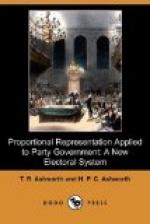+1. Sir John Lubbock’s Method.+—In his work on “Representation,” Sir John Lubbock says:—“The full advantage of the single transferable vote would require a system of large constituencies returning three or five members each, thus securing a true representation of opinion.” Three-seat electorates are, however, too small to secure accurate proportional representation; with parties evenly balanced, for instance, one must secure twice as much representation as the other.
The following rules are given to explain the working of the system:—
(1) Each voter shall have one vote, but may vote in the alternative for as many of the candidates as he pleases by writing the figures 1, 2, 3, &c, opposite the names of those candidates in the order of his preference.
COUNTING VOTES.
(2) The ballot papers, having been all mixed, shall be drawn out in succession and stamped with numbers so that no two shall bear the same number.
(3) The number obtained by dividing the whole number of good ballot papers tendered at the election by the number of members to be elected plus one, and increasing the quotient (or where it is fractional the integral part of the quotient) by one, shall be called the quota.
(4) Every candidate who has a number of first votes equal to or greater than the quota shall be declared elected, and so many of the ballot papers containing those votes as shall be equal in number to the quota (being those stamped with the lowest numerals) shall be set aside as of no further use. On all ballot papers the name of the elected candidate shall be deemed to be cancelled, with the effect of raising by so much in the order of preference all votes given to other candidates after him. This process shall be repeated until no candidate has more than a quota of first votes or votes deemed first.
(5) Then the candidate or candidates having the fewest first votes, or votes deemed first, shall be declared not to be elected, with the effect of raising by so much in the order of preference all votes given to candidates after him or them, and rule 4 shall be again applied if possible.
(6) When by successive applications of rules 4 and 5 the number of candidates is reduced to the number of members remaining to be elected, the remaining candidates shall be declared elected.
Objection is commonly taken to this method on account of the element of chance involved in the distribution of surplus votes. Suppose the quota to be 1,000, and a candidate to receive 1,100 votes, the 100 votes to be transferred would be those stamped with the highest numerals. But if the hundred stamped with the lowest numerals or any other hundred had been taken the second choices would be different.
Strictly speaking, however, this is not a chance selection—it is an arbitrary selection. The returning officer must transfer certain definite papers; if he were allowed to make a chance selection it would be in his power to favour some of the candidates.




